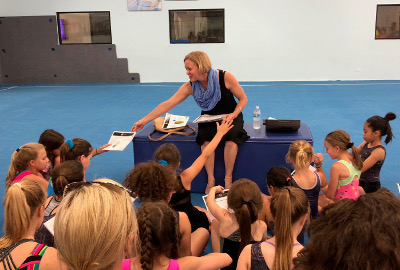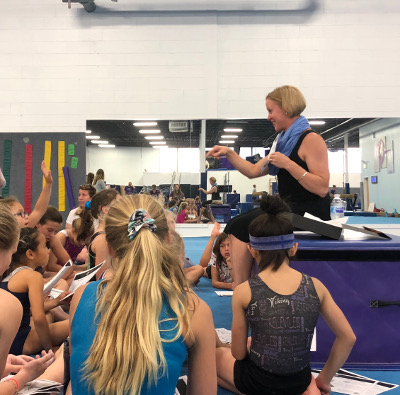On Friday, June 15th, we had an exciting visitor to Viking Gymnastics & Dance! Andrea Rudser-Rusin, a registered dietician and athletic trainer, came to talk to our USAG team gymnasts about the importance of nutrition and healthy eating habits for athletes. Ms. Rudser-Rusin works as an individual consultant on nutrition matters with SportWise Nutrition and Consulting, LLC, as well as teaches sports nutrition at DePaul University in Chicago. She has a bit of familiarity with gymnastics but has mostly focused on swimming and running. However, her advice holds true for all sports!
Andrea began her visit by sharing her background with the gymnasts and asking them about their experiences with cooking and eating. She brought pictures and diagrams (linked and starred* below) to help everyone follow along. Andrea asked the gymnasts (and parents!) what they like to eat and cook, giving some gentle advice about what of the childrens’ favorite foods were good and what might be a little less beneficial. Apparently, Nutella is not the healthiest option of condiment! Who’d have thought?!
When and What to Eat

Andrea passes out her handouts, linked in this article.
After introducing the audience to some general food tips, Andrea went through the first couple of her handouts, which included information on how best to re-fuel* throughout the day as well as pie charts and descriptions of healthy and balanced meal options for both days of regular exercise* level and days of high-intensity* workouts. The basic advice was to make sure all meals are balanced in terms of nutrients, and that athletes should make sure they eat something about every three to four hours, focusing on small, fuel-rich snacks in between meals. She recommended a website called myplate.gov to help figure out how to make sure we have the right balance of nutrients in our diets. My Plate is the new and updated version of the food pyramid that us adults learned about back in grade school. Andrea also shared a modified My Plate more geared towards athletes, whose nutrition needs are slightly different from the general public’s.
Get Those Nutrients!
As for the specifics of what an athlete’s balanced diet should look like, Andrea broke it down into different nutrient groups. Three of the most important for athletes specifically are protein, carbohydrates (which Andrea also calls “fuel”), and dairy. These three nutrients provide much-needed support to the departments of muscle health and healing. Both of these are extra important for athletes, who put more stress on their bodies than non-athletes. After these three nutrient groups, Andrea talked about fruits, vegetables, and grains, saying “Stuff from the ground has carbs, or fuel, that our body uses to jump around and explode off the mat.” She further emphasized the importance of eating a variety of these ground foods, as “no one food fixes all!” and of not overdoing it on the grains. When in doubt, she said, “let’s get back to the basics and eat real food!” With this advice, Andrea provided a “grocery shopping list*” with recommended food options from each of the above categories, with plenty of blank spaces for families to add their own favorite healthy options.
After going through the handouts, Andrea asked if the audience had any questions. This led to more specific discussions of certain food-related topics. She told us how to cook an egg in the microwave, what sorts of health bars are the best to eat and which ones to avoid (the fewer ingredients the better!). She also told us what kinds of nuts, fish, or veggies make the best meal and snack choices. Ultimately, we should regularly refuel our tanks with a variety of healthy foods, focusing on as natural of foods as possible for the highest concentration of important nutrients like calcium, healthy fats and sugars, carbohydrates, protein, iron, and fiber. Unhealthy “junk” foods can of course still be consumed (she’s not crazy!), but we should control the amount and frequency with which we eat them and eat them in addition to healthy alternatives, not instead of them.
Nutrition Conclusion: Moderation and Balance Rule the Day

Andrea finishes the visit by answering questions from the audience and reminds us all to maintain healthy and balanced nutrition habits!
To close, Andrea revisited her most important pieces of advice and gave some recommendations for places to find more information. She recommended eatright.org, the online home of the Academy of Dietetics, as a source of information and said to watch out for nutritionists whose names are not followed by RD, the degree for registered dieticians, as they may not have the same educational background as those with a formal degree. She repeated her advice to consume a wide variety of balanced foods with each meal and in-between-meals snack, emphasized the importance of eating in the morning and after workouts (even when those workouts immediately precede sleep). Coach Gena finished off the evening by tying Andrea’s words into gymnastics here at Viking. While Andrea talked only to our competitive team families, we wanted everyone to have access to this important advice. Healthy nutrition habits are crucial to athletes at every level of involvement in their sport, and the Viking Gymnastics & Dance family wants to make sure everyone has the opportunity to learn how to take care of themselves at home to get the most out of their athletic endeavors here at the gym!
Thank you so much to Andrea Rudser-Rusin for coming to talk to us, and we hope you all learn as much from her as we did! Bon Appétit!
